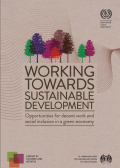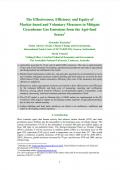Using novel data on patents, trade of equipment goods, and foreign direct investments and insights from the economic literature, the paper seeks to lay out the state of knowledge on the role of innovation and the diffusion of technologies in the greening of global value chains as well as some of the main policy issues. A special emphasis is put on developing countries -- distinguishing emerging economies and least-developed countries -- and on climate-mitigation technologies. Emerging economies are already reasonably well integrated in the global economy. As a consequence, technologies flow in through the imports of capital goods and local investments by multinational enterprises owning technologies. Pushing further technology transfer requires strengthening intellectual property rights, lowering barriers to trade and investments and improving technological absorptive capacities. In contrast, their role in innovation is limited. Standard tools of innovation policy - public research and development, public support to private research and development, better access to finance - should develop.

This joint study by the International Labour Organisation (ILO) and the United Nations Environment Programme (UNEP) highlights that the transformation to a greener economy could generate 15 to 60 million additional jobs globally over the next two decades and lift tens of millions of workers out of poverty. The report documents evidence that for countries at all levels of development the drive towards environmental sustainability and greener economies is gaining momentum. The study indicates that job growth has been particularly strong in the renewable energy sector, with a global increase of 21 per cent per annum. As a result, the sector now employs close to 5 million workers; more than double the number employed only a few years ago.
This summary was prepared by Eldis.
Guide dealing with the process of measuring the carbon footprint of products along the value chain, known as Product Carbon Footprints (PCFs), in the agri-food sector - provides an introduction to (PCF); outlines various types of PCF schemes and initiatives; describes steps involved in calculating PCFs, illustrating each step through case study examples; presents methodological issues and problems in calculating PCFs with a focus on data, uncertainty and issues particularly relevant to developing countries; gives an overview of potential mitigation measures; appendices include links to relevant websites, a glossary of related terms, and a list of frequently asked questions.
This summary was prepared by Eldis.

Agriculture accounts for 13 per cent of global GHG emissions. This rises to approximately 30 per cent if land clearance for farming, agrochemical production and trade in agricultural and food products are attributed to the sector. Market based mechanisms (carbon tax, cap and trade, payment for environmental services) and voluntary mitigation measures (carbon labelling and food miles) are reviewed for their effectiveness (if they reduce emissions), efficiency (the costs of the measures) and equity (fairness to suppliers). Measures to reduce agricultural emissions are limited in their effectiveness and efficiency by the technical difficulty and high costs of measuring, reporting and verification. However, pricing carbon would be effective in internalizing negative externalities in the transport, processing, retail and consumer purchase and preparation of food. The Global Trade Analysis Project (GTAP) model is used to illustrate that a US$ 40 carbon tax implemented in the EU would have little negative impact on developing country exporters of agricultural products due to their low carbon intensity.

This paper provides key information about the North American natural products market with a special focus on selected South American and African products. Natural products in the North American market have experienced strong market growth in the last decade as consumers increasingly demand nutritional and cosmetic products derived from natural sources. This paper provides an overview of the market including a description of products, prices and distribution channels, as well as requirements for access in terms of regulations, standards, product presentation and application forms.
